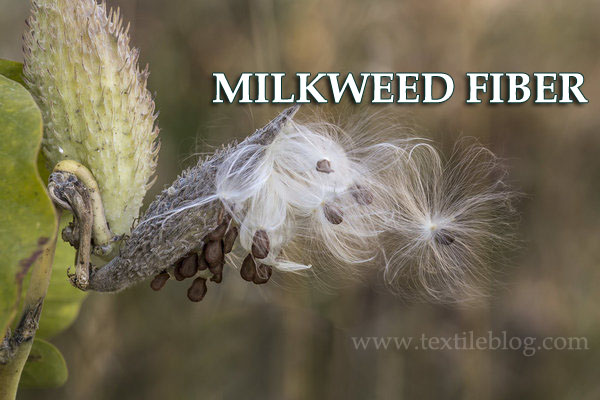What is Milkweed Fiber?
Milkweed fiber is a vegetable seed fiber. It is obtained from the seed’s milkweed plants (genus Asclepias). The plantis a native perennial in North America. The milkweed seed pods produce a silky lightweight fuzz, called silk or floss. Soft, lustrous fibers are yellowish white in colour. It is known as vegetable silk, stabraq, asclepias, zijdeplant, milkweed floss and so on. Milkweed fibers are too brittle to spin. It is usually used for upholstery padding. Milkweed fiber was used during World War II as substitutes for Kapok in lifebuoys.

Milkweed Producing Countries:
- South and Central America
- Southern Canada
- India
- Mexico, etc.
Structure of Milkweed Fiber:
Milkweed is soft, buoyant, lustrous floss is yellowish-white in colour. It is made up of individual fibres that are about 1 to 3 cm in length and 20 to 50 microns in diameter. The seedpods containing the floss which are mechanically processed. Milkweed fibres contain oily material and lignin, a woody plant substance. This substance makes milkweed fibre too brittle for spinning.
Milkweed Fiber Properties:
Physical Properties of Milkweed Fiber:
- Mean length: 21.3 mm
- Strength: 23.0 g/tex
- Fineness: 2.4
- Elongation: 6.0%
- Diameter: 10-18 μm
- Density: 0.97 g/cc
Chemical composition of Milkweed Fiber:
- Cellulose (wt %): 50- 55.0
- Hemicellulose (wt %): 24.0
- Lignin (wt %): 18.0
- Sugar (wt %): 2-3
- Wax (wt %): 1.0–2.0
- Ash (wt %): 0.5-1
Mechanical properties of Milkweed:
- Fiber length: ~ 2 cm
- Tensile Strength (MPa): 381.0
- Elongation at Break (%): 2.1
- Young’s Modulus (GPa): 4.0
Processing of Milkweed Fiber (Traditional):
1. Collect seedpods: Seed pods are only ripe during summer and into fall. There is a narrow window of time in which it has to be collected the seeds.
2. Separate seeds from fluff: The seeds are attached to the fluff so that it can easily blow away in the wind to reproduce. It is a very time-consuming process to separate the two. Then dumping both into the makeshift seed separator contraption; and giving it a few spins by using the pipe lever. Seeds fall to the bottom and the fluff floats around the top. Opening the lid afterward sent fluff flying everywhere. But this method is faster than separating by hand.
3. Weigh fibers: Then select milkweed fluff, according to different ratios of wool to which are wanted to attempt to spin.
4. Card fibers: Once the correct ratios are measured, then it needed to be carded. It is the most time-consuming process. It has to brush the two fibers over and over again until it’s all evenly lined up in the same direction.
5. Roll into rolag: When the fibers are all aligned, then it will be rolled into a machine. That is called a ‘rollag’. Rollag is basically just a concentrated form of the blended fibers that one spins with.
6. Spin: By using a wheel, milkweed fiber finally is hand-spun all the different samples.
7. Ply: After spinning two separate rolags on two separate bobbins, yarn is made by plying it’s together.
Application of Milkweed Fiber:
- Milkweed floss is used in such water-safety equipment as life jackets and belts. It can float in water 30 times much than its own weight.
- Milkweed made material is used as upholstery padding and insulation material.
- Milkweed plant is potentially poisonous. But it is also used for medicinal purposes.
- Milkweed fluff used to make lifejackets since World War II.
- Mosquito retardant fabric is experimentally made from milkweed fiber.
- Used in sportswear for insulation cause, it’s six times warmer than wool.
- Used in oil absorption.
- Suitable for technique clothing.
- Used in damp proofing materials.
The Future of Milkweed Fabric:
Sustainability becomes an increasingly pressing priority in textile industry. Natural material with a minimal ecological impact is being sought out by textile industry. In textile and apparel industry cotton is the most used among the various kinds of seed fiber.
Cotton fiber had been used for millennia by people of ancient Egypt, China, India, etc. Cause, it makes a soft and breathable fabric that is absorbent and comfortable. But it is also one of the most environmentally damaging of all fibers utilized in the textile and apparel industry. Cultivation of cotton is also a water-intensive process which requires at least 20 inches of rain per year. A cotton made shirt requires 2,700 litters of water. But one person drinks same amount in 2.5 years. So, we have to find an alternative of cotton.
You may also like: Milk or Casein Fiber: An Overview
This could be kapok, coir and also milkweed fiber. Milkweed fiber can be excellent alternative of cotton. Its cultivation and textile processing require less water than cotton and can give excellent output to making apparel. If we can reduce the natural weakness of milkweed fiber by blending with other fiber we can get a better result than cotton. Consequently, researchers have to make more research to make milkweed fiber more sustainable technical textile segment.
References:
- A Comparative Study on the Dyeability of Stabraq (Milkweed) Fibers with Reactive Dyes by Z. Bahreini and A. Kiumarsi
- Archana Jain, Deepali Rastogi, Bhawana Chanana, M.S.Parmar, Aditi Dhama “Extraction Of Cornhusk Fibres For Textile Usages” IOSR Journal of Polymer and Textile Engineering (IOSR-JPTE) e-ISSN: 2348-019X, p-ISSN: 2348-0181, Volume 4, Issue 1 (Jan. -Feb. 2017), PP 29-34
- Milkweeds: A Conservation Practitioner’s Guide by Brianna Borders and Eric Lee-Mäder
- Hossein Hasani, M. Zarrebini, S. Hassanzadeh “Evaluating the Acoustic Properties of Estabragh (Milkweed)/Hollow-Polyester Nonwovens for Automotive Applications” Published 2013, Materials Science, Journal of Textile Science & Engineering, DOI:10.4172/2165-8064.1000157
- https://www.britannica.com/topic/milkweed-floss
- https://xerces.org/blog/harvesting-milkweed-seed-pod-and-plan
- https://fashionista.com/2020/01/future-sustainable-fashion-materials-milkweed-floss
Author of this Article:
Md. Mahedi Hasan
B.Sc. in Textile Engineering
Textile Engineering College, Noakhali.
Email: mh18.bd@gmail.com
